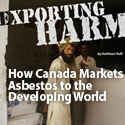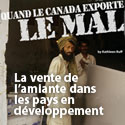Kathleen Ruff, RightOnCanada.ca
An Italian court has sentenced two leading asbestos industrialists to sixteen years in prison for criminal conduct in covering up the hazards of asbestos.
Yet, unbelievably, at the upcoming May meeting of the UN Rotterdam Convention, Russia will be fighting to carry on the same deadly deception in order to export asbestos, while covering up its hazards.
What is shocking is that the UN’s International Agency for Research on Cancer (IARC) is collaborating with Russian asbestos propagandists who are determined to sabotage the UN Rotterdam Convention and prevent chrysotile asbestos from being listed as a hazardous substance under international law. This would permit Russia to continue exporting asbestos without being required to disclose that it is hazardous.
Russia’s foremost promoter of chrysotile asbestos, Dr. Evgeny Kovalevskiy, is lead scientist at the Scientific Research Institute of Occupational Health of the Russian Academy of Medical Sciences (SRIOH). Both Dr. Kovalevskiy and this Institute have for years been promoting the interests of the asbestos industry. In doing so, Dr. Kovalevskiy has misrepresented the findings of scientific research he and others carried out at the Uralasbest mine in Russia, claiming that these findings showed that chrysotile asbestos was not causing harm to Russian asbestos workers, when the findings showed no such thing.
In 2012, Dr. Kovalevskiy was a witness on behalf of the Brazilian Chrysotile Institute (an asbestos lobby organisation) before the Supreme Court of Brazil, arguing that Brazil should not ban chrysotile asbestos and that chrysotile asbestos should not be put on the Rotterdam Convention’s list of hazardous substances. Kovalevskiy falsely claimed that his Uralasbest research showed that chrysotile asbestos can be safely used and should continue to be used.
IARC turns a blind eye to misrepresentation of scientific findings
Misrepresenting research data so as to advance the interests of the asbestos industry violates basic scientific and ethical standards. Yet IARC has appointed Dr. Kovalevskiy and his Institute (SRIOH) as collaborators in an IARC research project on workers at the same Uralasbest mine, despite the fact that Dr. Kovalevskiy and SRIOH are dedicated asbestos propagandists and despite the fact that Dr. Kovalevskiy for fifteen years has misrepresented the findings of his earlier Uralasbest research to the advantage of the asbestos industry.
At the 6th Conference of the Parties to the Rotterdam Convention (COP6) in May 2013, Dr. Kovalevskiy, who was part of the Russian delegation at COP5 in 2011, will be fighting to defeat the listing of chrysotile asbestos. He will be wearing two hats – one as a lobbyist for the Russian asbestos industry and one as an IARC scientific collaborator.
Scientists around the world have written to Dr. Christopher Wild, the director of IARC, asking that IARC end its collaboration with Dr. Kovalevskiy and his Institute. They have asked for Dr. Wild’s resignation, if he is not willing to take action to end this collaboration, which violates the scientific and ethical standards that IARC is expected to uphold.
Earlier letters from scientists to Dr. Wild and to Margaret Chan, criticized other instances of collaboration by IARC with activities by Dr. Kovalevskiy and his Institute to promote asbestos use. In a letter of December 13, 2012, scientists and health activists criticized IARC’s participation in a sham scientific conference in Kiev in November 2012, organized by Dr. Kovalevskiy, SRIOH and the Russian Ministry of Health, which had as its agenda to defeat the listing of chrysotile asbestos at the May Rotterdam Convention conference.
In addition, the scientists criticized the paper that IARC presented at the Kiev conference, pointing out that the paper included outdated and incorrect data, which minimized harm caused by chrysotile asbestos. It is hard to believe that this was simply incompetence on IARC’s part, as IARC is fully aware that the data it presented was incorrect, but any alternative explanation for this strange conduct is even more disturbing.
To date, these serious concerns have been ignored. IARC has posted information on its website regarding the Uralasbest project, showing that the research is financed by the Russian Ministry of Health, a strong supporter of asbestos use. The company that owns the Uralasbest mine and the Russian Ministry of Health are, it seems, in charge of collecting the data that the study will rely on.
In Russia, with a population of 141 million people, there is not a single scientist or a single scientific organisation that opposes the Russian government’s policy of promoting use of chrysotile asbestos. Or, at any rate, there is not a single scientist or scientific body that dares to do so.
President Putin has declared his strong support of the Russian asbestos industry. It is widely understood to be unwise to challenge President Putin’s policies.
In a Russian newspaper, Vladimir A. Kochelayev, Deputy Director General of JSCo Uralasbest, is already expressing the hope that IARC’s research project at his Uralasbest mine will bring an end to discussions on banning chrysotile asbestos.
Russia and the Rotterdam Convention
The purpose of the Rotterdam Convention is to require responsible trade in hazardous substances, which increasingly are exported to developing and middle income countries. There is widespread concern that receiving countries may lack the necessary information and resources to protect their population and their environment from being harmed by such hazardous substances. The Convention therefore empowers developing and middle income countries by requiring that Prior Informed Consent be obtained, prior to export of any substance on the Convention’s list.
At the May meeting in Geneva, the recommendation of the Convention’s 31-member expert scientific committee to place chrysotile asbestos on the Convention’s list of hazardous substances will be put forward for the fourth time. Chrysotile asbestos represents 95% of all asbestos traded over the past century. For the past twenty years, chrysotile asbestos represents the totality of the global asbestos trade.
Up until now, Canada has acted as leading saboteur, by blocking consensus to list chrysotile asbestos. Canada has cynically stated, however, that since Quebec’s asbestos mines are now closed down, there is no purpose for Canada to continue to block the listing and it will cease to do so.
At the May conference, however, Russia will, for the first time, be participating as a full party to the Convention. Previously, Russia attended with just observer status.
Russia is the world’s leading exporter of asbestos, by far. Of the total world figure of two million tons of asbestos mined in 2011, Russia produced one half of that amount: one million tons. And Russia exports three quarters of the asbestos it mines, so that in 2011, it exported 748,564 tons.
At the May Rotterdam Convention conference, Dr. Kovalevskiy will almost certainly make use of his status as an IARC collaborating scientist in arguing that chrysotile asbestos should not be listed as a hazardous substance and that no action should be taken to control the export of chrysotile asbestos until after the Uralasbest project has been completed.
IARC’s conduct represents a sad betrayal of scientific integrity and of the protection of public health in developing and middle income countries.



Tue, Apr 16, 2013
Asbestos